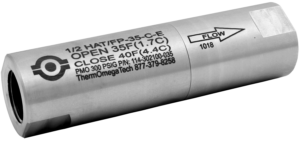Thermostatic Freeze Protection: Winter is the time to protect your pipes and personnel.
Water-bearing piping must be appropriately winterized to keep temperature-sensitive processes and equipment functioning optimally throughout the freeze season. When water lines to cooling and condensate systems, safety showers, and eyewash or facewash stations are left exposed to the elements, or their heat tracing fails, freezing temperatures can cause frozen or burst piping. This can lead to overheated equipment and severely dangerous working conditions for your employees, which can interrupt systems, burst piping, and cause lengthy and costly repairs.
If safety shower, eyewash, or facewash station water lines freeze, personnel could be at significant risk of being unable to cleanse after contamination exposure. Condensate drain lines are also in danger of freezing even if it is electrically heat traced and the tracing malfunctions or the facility loses power.
ThermOmegaTech’s self-actuating temperature control valves are the ideal water line freeze protection solution.
The HAT/FP valve is designed to sense the water temperature in the pipe or ambient temperature, depending on installation. The valve will gradually open to bleed off the cold water when temperatures approach the valve’s set point, typically 35°F (1.6°C).
Once the flow is initiated, the valve will remain open until the discharge water temperature is 5 degrees above that, typically 40°F (4.4°C). Once the freeze danger passes, the valve will modulate closed again to conserve water and reduce wastewater disposal costs.
These 100% mechanical valves require no power source to operate, eliminating the human errors associated with manual valves. They can also save you thousands on your water or energy bills.
Result: Guaranteed freeze protection and water savings because of the reliable and automatic HAT/FP thermostatic valves.
Read the feature on HAT/FP valves in the latest issue of Plant Engineering.
